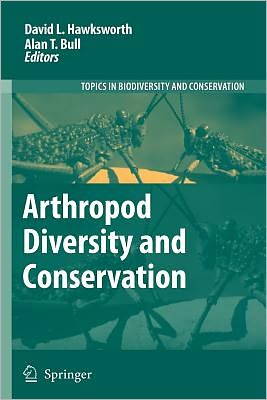

 |

|

Sold Out
Book Categories |
Introduction.- Arthropod diversity in Lama forest reserve (South Benin), a mosaic of natural, degraded and plantation forests; T. Lachat et al.- Ecosystem disturbances and diversity increase: implications for invertebrate conservation; R. Dias Loyola et al.- The diversity and distribution of the fruit bat fauna (Mammalia, Chiroptera, Megachiroptera) of Danjugan Island, Cauayan, Negros Occidental, Philippines (with notes on the Microchiroptera); R. O’Malley et al.- Effects of landscape elements on the distribution of the rare bumblebee species Bombus muscorum in an agricultural landscape; T. Diekötter et al.- How ant nests increase soil biota richness and abundance: a field experiment; A.M. Boulton, K.D. Amberman.- Host specificity, alpha- and beta-diversity of phytophagous beetles in two tropical forests in Panama; F. Ødegaard.- Vertical and temporal patterns of biodiversity of fruit-feeding butterflies in a tropical forest in Uganda; F. Molleman et al.- Associations between weevils (Coleoptera: Curculionidea) and plants, and conservation values in two tussock grasslands, Otago, New Zealand; T.J. Murray et al.- Effects of management intensity and season on arboreal ant diversity and abundance in coffee agroecosystems; S.M. Philpott et al.- Influence of habitat fragmentation on the genetic variability in leaf litter ant populations in tropical rainforests of Sabah, Borneo; T.O. Bickel et al.- Comparing relative model fit of several species-accumulation functions to local Papilionoidea and Hesperioidea butterfly inventories of Mediterranean habitats; A. Jiménez-Valverde et al.- The habitat requirement of the Genji-firefly Luciola cruciata (Coleoptera : Lampyridae), a representative endemic species of Japanese rural landscapes; M. Takeda et al.- Diversity of Chrysomelidae (Coleoptera) in Galicia, Northwest Spain: estimating the completeness of the regional inventory; A. Baselga, F. Novoa.-Topographic heterogeneity plays a crucial role for grasshopper diversity in a southern African megabiodiversity hotspot; S. Gebeyehu, M.J. Samways.- Landscape effects on the genetic structure of the ground beetle Poecilus versicolor STURM 1824; A.-C. Sander et al.- The response of ground beetles (Coleoptera: Carabidae) to selection cutting in a South Carolina bottomland hardwood forest; M.D. Ulyshen et al.- Factors influencing bug diversity (Insecta: Heteroptera) in semi-natural habitats; C. Zurbrügg, T. Frank.- Insect colonisation of fruiting bodies of the wood-decaying fungus Fomitopsis pinicola at different distances from an old-growth forest; M. Jonsson, G. Nordlander.- Dragonfly assemblages in arid tropical environments: a case study from western Namibia; F. Suhling et al.- Richness, abundance, and complementarity of fruit-feeding butterfly species in relict sacred forests and forest reserves of Ghana; J.L. Bossart et al.- Ecological impact assessment of the Aznalcóllar mine toxic spill on edaphic coleopteran communities in the Guadiamar River basin (Southern Iberian Peninsula); A.M. Cárdenas, J.M. Hidalgo.- Diversity of the scuttle fly (Diptera: Phoridae) communities in the plantations of moist pine forests of the Bialowieza Primeval Forest and the Tuchola Forest (Poland); E. Durska.- Spatial distribution of ground beetles (Coleoptera: Carabidae) and moths (Lepidoptera) in the Mrtvý luh bog, Šumava Mts (Central Europe): a test of habitat island community; A. Bezdek et al.- Surrogate habitats demonstrate the invasion potential of the African pugnacious ant; P. Addison, M.J. Samways.- Impacts of catastrophic earthquakes on the insect communities in estuarine mangroves, northern Taiwan; C.-J.W. Maa et al.- Countryside Stewardship Scheme and butterflies: a study of plant and butterfly species richness; R.G. Field et al.- Habitat specificity and variation of coleopteran assemblages between habitats in a Southern African (Swaziland) agricultural landscape; C.N. Magagula.- Effects of habitat disturbance can be subtle yet significant: biodiversity of hawkmoth-assemblages (Lepidoptera: Sphingidae) in Southeast-Asia; J. Beck et al.- The importance of ants and high-shade management to coffee pollination and fruit weight in Chiapas, Mexico; S.M. Philpott et al.- Sampling to assess a re-established Appalachian forest in Ohio based on gelechioid moths (Lepidoptera: Gelechioidea); S.R. Bucheli et al.- Diversity patterns of Bornean butterfly assemblages; D.F.R. Cleary, M.J. Genner.
Login|Complaints|Blog|Games|Digital Media|Souls|Obituary|Contact Us|FAQ
CAN'T FIND WHAT YOU'RE LOOKING FOR? CLICK HERE!!! X
 You must be logged in to add to WishlistX
 This item is in your Wish ListX
 This item is in your CollectionArthropod Diversity and Conservation
X
 This Item is in Your InventoryArthropod Diversity and Conservation
X
 You must be logged in to review the productsX
 X
 X

Add Arthropod Diversity and Conservation, Despite their enormous bulk and complexity of architecture, plants make up only around a quarter of a million of the 8 million or so species on Earth. The major components of biodiversity, instead, are the smaller, largely unseen, silent majority of inver, Arthropod Diversity and Conservation to the inventory that you are selling on WonderClubX
 X

Add Arthropod Diversity and Conservation, Despite their enormous bulk and complexity of architecture, plants make up only around a quarter of a million of the 8 million or so species on Earth. The major components of biodiversity, instead, are the smaller, largely unseen, silent majority of inver, Arthropod Diversity and Conservation to your collection on WonderClub |